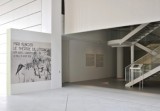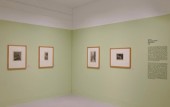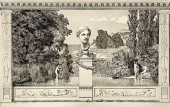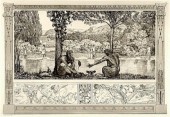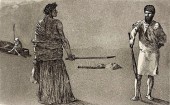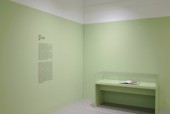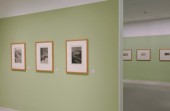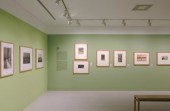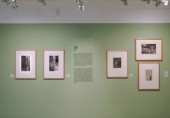The browser will either open the file, download it, or display a dialog.
Max Klinger – Le théâtre de l’étrange, Les suites gravées, 1879–1915
Musée d’Art Moderne et Contemporain de Strasbourg, Strasbourg
May 12–August 19, 2012
Catalogue:
Max Klinger – Le théâtre de l'étrange, Les suites gravées, 1879–1915.
Contributions by Marie Gispert, Marsha Morton, Thierry Laps, and Marie-Jeanne Geyer.
Strasbourg: Éditions des Musées de Strasbourg, 2012.
270 pp.; 8 b/w illustrations, 218 color illustrations; catalogue entries, list of exhibited works, key dates, bibliography.
39€
ISBN: 9782351250976
Max Klinger – Le théâtre de l'étrange, on view at the Musée d’Art Moderne et Contemporain de Strasbourg (MAMCS) in the summer of 2012, brought together Max Klinger’s graphic series, the majority of which are held within its own collections, supplemented with loans from the Bibliothèque Nationale Universitaire de Strasbourg and the Staatliche Kunsthalle in Karlsruhe. Over the course of three decades, Klinger created fourteen series of etchings and aquatints, all of which were represented in Le théâtre de l’étrange. Although Klinger is well known for his complex historical and literary allusions, the most notable aspect of the show was its steadfast commitment to allowing the quality of these images to shine on their own. The prints were accompanied by very little text, allowing viewers to become absorbed in the artist’s masterful technique and enigmatic subjects. However, in the text that was presented, the exhibition subtly offered an important analysis of the art historical narratives of the period. Between 1871 and 1945, Alsace (the region on the eastern border of France of which Strasbourg is the capital) and Lorraine to its west were controlled at various points by France and Germany. The perpetual tension between these two nations, which was acutely felt in Alsace and Lorraine, reached the French and German artistic communities as well, and contributed to the marginalization of German artists in nineteenth- and twentieth-century France. Strasbourg’s complex history made it an ideal place to re-consider Klinger’s work and its place within the history of art. However, this element did not overpower the core objective of the exhibition, which was to highlight Klinger’s remarkable capabilities with the graphic arts.
From his earliest sets of prints, Max Klinger (1857–1920) showed confidence with the medium, which he dubbed Griffelkunst, or “stylus art.” Throughout his work with Griffelkunst, Klinger displayed a level of deference toward the rich history of the medium, with subtle nods to Albrecht Dürer, Francisco Goya, and Hokusai. More importantly, his constant experimentation with technique and subject matter makes the print series a worthy choice for an exhibition. That is not to say, however, that the curatorial decisions were likely to have been easy. Although Klinger has remained relatively well-known since the late-nineteenth century, the way that his work has been positioned within standard art histories is generally unfortunate. An artist brought up in Saxony and trained near the Franco-German border in Karlsruhe, Klinger was destined to have a complicated relationship with the European artistic communities of his time. Conceding his importance but unsure of how to situate him, art historians outside of Germany have traditionally placed Klinger, at best, within fin-de-siècle German Symbolism and, at worst, as simply a precursor to French Surrealism.[1] The exhibition did not shy from these adages in its introductory wall text, citing Klinger’s influence on artists like Käthe Kollwitz, Edvard Munch, Max Ernst, and Giorgio de Chirico. But Klinger’s mastery of Griffelkunst alone deserves a more prominent place in the history of art, and this seemed to be the guiding principle of the exhibition. While the wall texts point briefly to themes that recur within Klinger’s oeuvre, explanations of the complex literary and artistic allusions in his work are left to the catalogue. This dearth of information in the space of the galleries has two benefits: first, the viewer could focus on the quality of Klinger’s graphic capabilities without being bogged down in the complicated process of unpacking his allusions; and, as a result, one was forced to meander through the disorienting ambiguity, violent juxtapositions, and obscurantist references that are crucial to Klinger’s practice. The exhibition did not leave the viewer with a clear comprehension of the images, nor was it meant to, and it was thus completely in line with what Klinger sought in his work. This was an effective strategy for bringing attention to Klinger’s technical mastery, and for separating it from the artist’s problematic legacy.
But there was more beneath the surface of Le théâtre de l’étrange. Perhaps most importantly, the curators imbued the beautifully crafted catalogue in particular with a clear sense of geography––or, rather, with the dynamism and volatility of geo-political boundaries. Klinger worked in the midst of a tense era for a German artist seeking international acclaim. His first series appeared less than a decade after France’s humiliating defeat in the Franco-Prussian War (1870–71), which led to the surrender of Alsace and Lorraine to the Germans. This factor would affect, however covertly, the French response Klinger’s work for decades. Yet, as Mayor Roland Ries notes in the catalogue, Strasbourg’s enduring Franco-German character made it an ideal place to mount the first monographic exhibition of Klinger’s graphic work in France: “Max Klinger,” he writes, “eloquently illustrates the link between German and French culture” (5). But while the imperative of situating Klinger in the context of two national artistic communities is fundamental to the excellent catalogue essays by Thierry Laps and Marsha Morton, specific cultural references were left largely unexplained in the galleries. The viewer, most likely unacquainted with Klinger’s cultural milieu, was at the mercy of his impassioned, divergent imagination, and is rewarded for submitting to the artist’s oneiric whims.
The exhibition was organized chronologically, separated into eight gallery spaces split between two floors. After an abbreviated introductory text, the viewer was met with an exciting first set of images (fig. 1). With Opus I: Radiertre Skizzen (Etched Sketches) (1879), the accompanying wall text informed viewers that although these scenes “do not appear to express any particular theme,” they “already convey in their strange combination and curious atmosphere, a corpus of themes that were to permeate Klinger’s engravings.” The nature of humanity, the ambiguity of nature, and the phantasmagorical are invoked in these early works, all within the context of a discrete set of images that is steadfastly non-narrative. This last point was crucial for Klinger in the development of his practice, and may have influenced the choice of limiting the length of the wall texts. Certainly, there are “stories” present in Klinger’s graphic series (Ovid’s Metamorphoses and the seventeenth-century novel Simplicius Simplicissimus, for example), but most often they serve primarily as jumping off points for thematic exploration, rather than presenting a coherent plot structure. The exhibition avoids leading the viewer to a concrete explanation of the images’ meanings, especially with works like Opus III: Eve und die Zukunft (Eve and the Future), by identifying, but not elucidating Klinger’s literary references (fig. 2). In his famous essay, Malerei und Zeichnung (Painting and Drawing), Klinger describes the prevailing impulse toward locating narrative coherence in visual representation. The public by-and-large wants “to have something that will suggest a story, something to 'understand'.”[2] And while, in Klinger’s mind, the imperative of painting is to “express the colored, bodily world in a harmonious manner,”[3]Griffelkunst leaves the artist at his leisure to exploit the “idea,” the poetic or symbolic, without necessarily relying on naturalistic harmony. In other words, the artist’s subjectivity becomes paramount, and visual representation is freed from its illustrative capacity.
Opus I also introduces the viewer to the variety of graphic techniques Klinger would continue to explore for decades. Each plate plays variously with line and tone, some eclipsing one in favor of the other, some oscillating between the two. In her catalogue essay, Marie Gispert argues that the technique Klinger employs in each work has significant bearing on its meaning, and while this is only marginally born out in the first series, it begins to become especially evident in Opus II: Rettungen Ovidischer Opfer(Rescues of Ovidian Victims) (1879). In the first image, Titelblatt (Evocation) [Title Page (Evocation)], Klinger juxtaposes a clean linearity in the framing arabesques (reminiscent of John Flaxman’s illustrations) with a tonally variegated landscape (fig. 3). He continues to play with the two stylistic modes throughout the series, and although Gispert argues that some of Klinger’s framework is “purely decorative,” one is inclined toward what Marsha Morton has suggested elsewhere––that, in the nineteenth century, the arabesque “was considered to be suggestive and associational in meaning; it was the language of dreams, capable of expressing imagination, alienation, and the irrational.”[4] It is reasonable to believe that Klinger utilized these decorative elements at least partially as foils to the narrative impulse, particularly in this series, one of his most narratively inclined. However, in later series, most notably Opus XI, we see the frame impinging on the representational space of the scenes, creating a dynamic between allegorical abstraction and linear progression. But even in images like Narcissus und Echo I, plate 7 of Opus II, Klinger utilizes these juxtapositions with great success (fig. 4). Multiple layers of meaning and representation pervade the image, from the assemblage of Ovidian moments in the background, to the faun and satyr in the foreground, to the symbolic allusions to love below, to the framing arabesques. In the final image of the series, Satyre (Beschluss)[Satyr (Conclusion)], Klinger presents himself poised in the face of an advancing Ovid brandishing a quill, affirming the challenge to classical tradition in his retelling, but still with a manner of deference to poetry’s elevated status (fig. 5).
Klinger’s relationship with the written word is complicated further as one encounters Opus V: Amor und Psyche (Cupid and Psyche) (1880), the only set of prints created specifically as illustrations for a text. The catalogue underscores the artist’s frustrating experience in creating this work: “The stress of complying with a text was unbearable,” Klinger later wrote to the poet Richard Dehmel. “The very concept of illustration became unbearable to me. . . I think the combination of words and images could not be more disastrous ” (99). While the exhibition organizers nonetheless maintain in both the catalogue and the wall text that the work belongs within the genesis of modern book illustration, the presentation of Opus V is one place where Le théâtre de l'étrange unfortunately falls short (fig. 6). As the work is comprised of a book, rather than a series of individually framed prints, the viewer was given two options for encountering the work: a copy of Amor und Psyche displayed in a vitrine and opened to plate 12 (The Arrival of Love), and, to its right, a small, mounted screen which scrolled automatically through digital images of the entire work. The latter was potentially ingenious, but suffered from only moderate-quality reproductions and overly rapid movement through the work. Had the concept been interactive, allowing the viewer to scroll through at his or her own pace, it would have come closer to replicating the experience of the book. The difficulty of incorporating the work into a retrospective of the entirety of Klinger’s graphic work is made all the more apparent by the fact that it is one of the only series that is not fully reproduced in the catalogue. This is somewhat understandable, as Amor und Psyche includes fifteen full-page illustrations and 31 vignettes, but one nonetheless gets the sense that the curators struggled with this series, just as Klinger had.
The next series, Opus VI: Ein Handshuh (A Glove), has been the most widespread and lasting of Klinger’s successes, and stood to benefit the most from the minimal curatorial explication one found throughout the exhibition (fig. 7). It is difficult to peruse the ten images without conjuring associations with André Breton’s Nadja or Max Ernst’s La Femme 100 Têtes, given, for example, the centrality of a glove in Breton’s narrative, and Ernst’s reliance on the kinds of nineteenth-century popular imagery that also had influenced Klinger (fig. 8). Ironically, as Thierry Laps points out in his essay, Ernst was the only member of the Surrealist group in Paris to give Klinger due credit; even so, Ein Handschuh has maintained its reputation largely because of its precursory evocation of the kinds of imagery that would occupy the Surrealists. Set in this exhibition, Ein Handschuh reveals its multivalent characteristics, beyond its proto-Surrealism. The first two plates in particular highlight the themes of social anxiety that would later inform Opus VIII: Ein Leben (A Life), Opus IX: Dramen (Dramas), and Opus X: Eine Liebe(A Love) (figs. 9 and 10). The exhibition catalogue emphasizes the importance of societal uncertainty in comprehending Klinger’s work. As Morton stresses in her essay,
The full measure of the anxiety and disorientation triggered by Klinger’s innovations can only be appreciated when set within the context of Gründerzeit (post-1871) society…The previous twenty years of material growth and rapid industrialization had propelled the middle-class to cultural and economic prominence. Events of that decade, however, fostered a new apprehension as they experienced the financial crash of 1873, the rise of urban crime, the formation of the social democratic party in 1878, the growth of women in the workplace and the advocacy of women’s rights. This led to disenchantment with aspects of modernism and a resulting cultural pessimism (21-22).[5]
The destabilizing affect of this situation on Klinger’s artistic consciousness is a key way through which Morton and others have resuscitated Ein Handschuh from its proto-Surrealist art historiographical position.[6] In situating Klinger in the context of Gründerzeit society (a period that has not traditionally been the focus of much attention in art historical narratives), the broader cultural factors at work in the images become as important as the artist’s expression of subconscious desire. Rather than spelling this out in the wall text, the viewer is given minimal contextualization, encouraged instead to explore Klinger’s graphic experimentation. This was a successful curatorial choice at many points in the exhibition, but here it would have been useful to underscore, as the catalogue does, how Ein Handschuh reflected contemporary society. Instead, the wall text notes that the series “is undoubtedly Klinger’s best-known portfolio,” and that it “is an astonishing study of desire in which the artist uncovers love’s peculiar ills and its insatiable greed for possession.” Although these characterizations draw attention to one of Klinger’s most important sets of images, they implicitly emphasize Ein Handschuh’s transcendent qualities much more than its historically particular ones.
Klinger’s later series would also perhaps have been more evocatively presented with some explanation of the artist’s social milieu. For instance, Opus X opens with a dedication to the marginally-known Swiss painter Arnold Böcklin, who is left unidentified in the wall text. Perhaps this absence is in keeping with the choice of distancing Klinger from Symbolism, with which Böcklin is typically associated, but it has the negative consequence of singularizing rather than contextualizing Klinger. It is the problem with which any monographic exhibition must grapple, and the MAMCS made the right choice in separating Klinger from the later movements to which he has been too closely attached. Yet at the same time, one is left with a vision of a solitary figure, rather than one who actively engaged with fellow artists, writers, and musicians. The only place where Klinger’s connections are really made clear is in the context of Opus XII: Brahmsphantasie (Brahms’ Fantasy), which is tacitly treated as the masterpiece of Klinger’s career in both the exhibition and the catalogue (fig. 11). Recordings of Brahms symphonies echo from the Brahmsphantasie gallery, and the wall text includes the composer’s famous response to Klinger’s works: “I see the music––and now, imperceptibly, I find myself swept away by your magnificent drawings; gazing at them, it is as if the music were echoing away into Infinity.” The final gallery, on the other hand, presents some additional graphic works by Klinger (book plates and illustrations in periodicals), most of which included references to one of the artist’s contemporaries (Wolfgang Singer, Wilhelm Bode, and Adolph Menzel), yet we are left in the dark as to any significance they might have had for the artist.
The catalogue largely makes up for the exhibition’s faults, situating Klinger both as a masterful graphic artist and as a figure poised at a unique historical moment. The small-scale reproductions within the essays, and the somewhat inexplicable inclusion of three poems by Klinger’s friend Richard Dehmel, are the catalogue’s only real deficiencies, which are surpassed by strong historical and visual analysis. Marie Gispert identifies the artist’s heterogeneous graphic techniques, his investigations of contemporary social realities, and his evocations of the subconscious as the elements that make his work most modern. The first category is dealt with most adeptly, and mirrors the overarching purpose of the exhibition. Morton’s essay, “Art on the Edge: Klinger at the Threshold of Modernism,” weaves an insightful picture of the cultural constellations that Klinger negotiated throughout his production. Citing wide-ranging influences from Goethe, Goya, and Schopenhauer to Darwin, Zola, and Japanese prints, Morton carefully explores what have been the most recuperated (and misinterpreted) elements of Klinger’s work. One of the primary causes of Klinger’s historiographical position, the dearth of critical scholarship on German art of the second half of the nineteenth-century, is subtly hinted at in Laps’ essay, “Le souvenir de Max Klinger en France, entre émergence et latence.” The author traces the critique of the poet Jules Laforgue, who promoted Klinger’s work in France, but whose relationship with the artist developed into one of “fascination and rivalry (38).” The story of Laforgue’s engagement with Klinger acts as a microcosm for the relationship between French and German artistic communities during and after Klinger’s lifetime, and implicitly calls into question the divided nature of many art historical narratives.
While each of the catalogue essays discusses, with varying degrees of urgency, Klinger’s place within the history of modern art, there is an underlying questioning of the teleology of the modernist narratives. The inclusion of Giorgio de Chirico’s essay, with its oft-cited characterization of Klinger as the “modern artist par excellence,” seems to play more into the discourses of historiography than as an argument for Klinger’s place in the modern canon. At its core the exhibition is successful primarily in its emphasis on visual immersion in the work of a complicated artist. Most importantly, at the conclusion of Max Klinger – Le théâtre de l’étrange, exhibition and catalogue, we are left with the image of an oeuvre that is captivating and complex, and that will stand to benefit from more scholarship of the quality presented by the MAMCS.
Sarah Schaefer
Columbia University
schaefer.sc[at]gmail.com
[1] Most publications devoted to Klinger have been produced in Germany, and very few of the English and French studies of his work were written after the early 1980s. In his 1977 introduction to Klinger’s graphic work, Kirk Varnedoe argued, in essence, that it is only with Surrealism in hindsight that we can fully appreciate Klinger’s images: “... the perspective of a century, and the experience of surrealism and film, can allow us to see even more clearly than Klinger’s contemporaries the ways in which his images work, and to explain them.” See Varnedoe, Graphic Works of Max Klinger (New York: Dover Publications, 1977), xxiv. Similarly, Eduard Beaucamp read Klinger through Symbolism and Surrealism, concluding that “Klinger has achieved an esthetic synthesis on a scale only realised again by the “abstract” artists of the 20th century.” See Beaucamp, Max Klinger, 1857–1920: Printed Graphic (Stuttgart: The Institute, 1981), 11.
[2] Max Klinger, Drawing and Painting, trans. Fiona Elliott and Christopher Croft (Birmingham: Ikon, 2005), 17–18.
[3] Ibid.
[4] Marsha Morton,“‘Malerei und Zeichnung’: The History and Context of Max Klinger's Guide to the Arts,” Zeitschrift für Kunstgeschichte, vol. 58, no. 4 (1995), 561.
[5] I am grateful to the author for providing me with a copy of the original, English-language version of her essay.
[6] For example, Jonathan Crary has described Ein Handschuh as “so pregnant with ordinary anxiety, the expectancy, the sublimated precariousness of a modernizing urban world...” See Crary, Suspensions of Perception: Attention, Spectacle, and Modern Culture (Cambridge, MA: MIT Press, 1999), 128–134.


